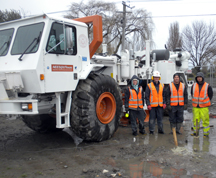T-Rex takes on shaky Christchurch
January 25, 2013
 |
|
T-Rex, a 64,000-pound shaker truck, will help earthquake engineers grapple
with a seismic challenge in Christchurch, New Zealand. T-Rex is based at
a University of Texas at Austin facility that is part of the Network
of Earthquake Engineering Simulation (NEES), a distributed laboratory with 14 sites around the United States. |
T-Rex, a massive, 64,000-pound shaker truck, is heading to New Zealand on Feb. 3 to help earthquake engineers grapple with a seismic challenge following a series of earthquakes that shook its second largest city, Christchurch, in 2011. As many as 7,500 homes were abandoned, and 30 percent of the structures in its central business district, including more than 20 15-plus-story buildings, have been demolished so far.
This earthquake hot spot on New Zealand's south island has one potentially fatal flaw: It's sitting on a bowl of jelly - sandy, swampy sediment on top of bedrock that traps and compounds the earthquake's vibrations. The soil liquefies, losing strength and stiffness, causing buildings to sink into the ground and crack apart.
Assistant professor Brady Cox, a geotechnical engineer at the University of Texas at Austin, just returned from Christchurch, where he used strategically placed arrays of seismometers to record ambient soil vibrations (microtremors) in an attempt to profile the deep, soft sediments underlying the city. Now, he will return with T-Rex to verify his findings.
T-Rex will pound and thud the earth, changing its vibration orientation with the push of a button, in order to generate various seismic waves that are recorded by sophisticated sensors. T-Rex will roll on its 5-foot-tall tires onto a cargo ship, Tonsberg v302, at Galveston, Texas and arrive in New Zealand in March. The seismic data gathered with T-Rex will inform engineers, on an area-by-area basis, how to rebuild structures in Christchurch to resist future earthquakes. It will also benefit seismically active areas of the United States underlain by similar deep sedimentary basins, such as Los Angeles and Seattle.
"Designing a quake-resistant building starts with the soil," Cox says. "The stiffness and layering of the soil has a profound effect on the strength of shaking felt during an earthquake. The soil stiffness is quantified by a shear wave velocity, the speed at which waves generated by the earthquake travel through the soil. Soft soils with slow shear wave velocities tend to amplify shaking during an earthquake. Information about the shear wave velocity of the soil is used to inform engineers and government officials about what is needed to design quake-resistant structures in given areas."
Engineers are confident they can design structures that can withstand earthquakes in New Zealand, the United States and other places with similar geotechnical challenges. But first engineers need to know more about the soil in each area. T-Rex can give them that vital information. Then, a foundation and structural system best suited for the particular site and building type can be designed. This may include options such as seismic base-isolation, placing alternating layers of lead and rubber between the foundations and columns to dissipate seismic waves.
The shaker truck's Texas home is one of 14 National Science Foundation sites that make up the George E Brown Jr. Network of Earthquake Engineering Simulation, led by Purdue University. Each site has its own specialized, often few-of-a-kind, costly testing equipment that is shared with researchers around the world. UT-Austin's T-Rex, for example, is the only known operating tri-axial vibroseis truck in the United States. Its trip down under will be its first outside the country.
Cox decided to devote his career to the study of earthquake engineering when he was studying for his master's degree. He was part of a research team that traveled to Turkey in the aftermath of the 1999 quake there.
"About 18,000 people lost their lives. I saw the devastation and the impact it had on people," Cox says.
But Turkey couldn't compare to Haiti, where he was on the scene shortly after the 2010 earthquake there.
"It was shocking," Cox says. "More than 300,000 people lost their lives in 45 seconds."
Besides losing most of its downtown and several neighborhoods, 185 lives were lost in the Christchurch earthquakes. Additionally, estimates of the economic impact of the Christchurch earthquakes range from $35-$50 billion, approximately a quarter to a third of the entire GDP for New Zealand.
"I know we can prevent this," he says. "Our hope is that our research can not only help Christchurch, Turkey and Haiti, but also the cities along the West Coast of the United States like Los Angeles and Seattle that face similar soil challenges.
Writer: Jeanne Norberg, NEES, 765-491-1460, jnorberg@purdue.edu
Contact: Brady Cox, 512-471-9162, brcox@utexas.edu
Note: High-definition video b-roll of T-Rex demonstration available from Maria Arrellaga, director of communication, Cockrell School of Engineering at the University of Texas at Austin. Contact: arrellaga@utexas.edu; Phone: 512-232-8060.

